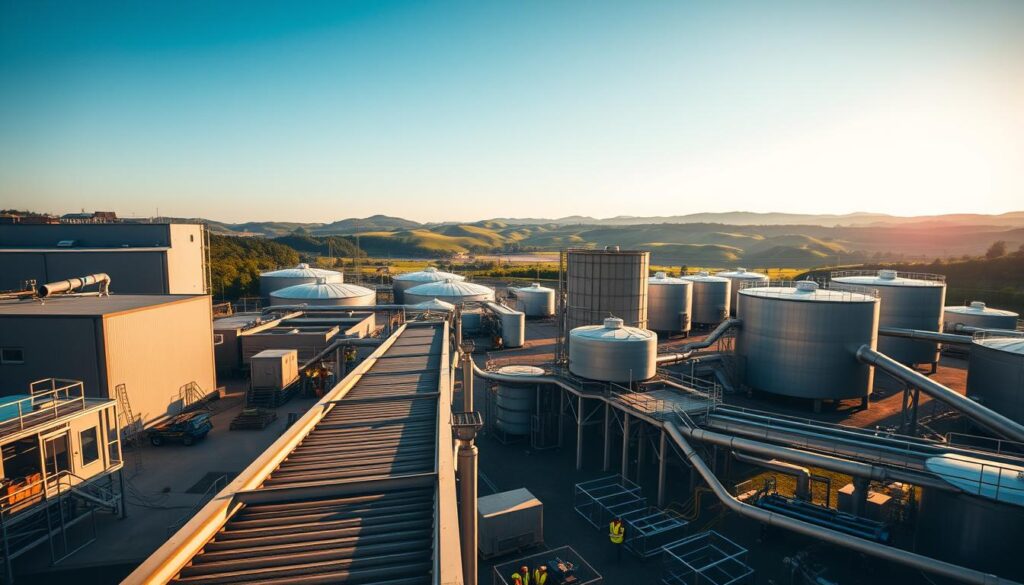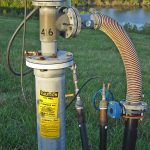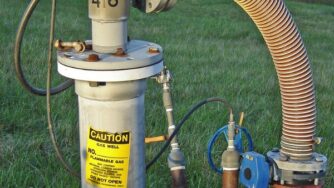In a quiet corner of Yorkshire, a local council recently transformed a decades-old rubbish site into an unexpected power source. Beneath the grassy mounds lay a hidden network of pipes capturing invisible emissions from rotting food scraps and garden clippings. This methane-rich mixture now fuels nearby factories and heats over 2,000 homes – turning yesterday’s leftovers into today’s renewable energy.
Organic materials buried in waste sites naturally break down without oxygen, creating a blend of gases. Roughly half of this mixture consists of methane – a compound 25 times more potent than carbon dioxide at trapping heat. Historically seen as a nuisance, modern engineering now redirects these emissions into valuable energy streams.
Across the UK and US, innovative projects demonstrate how capturing this resource tackles two challenges at once. It reduces harmful atmospheric releases while generating electricity for communities. From powering manufacturing plants to supplementing national grids, repurposed emissions demonstrate how sustainability and practicality can coexist.
Key Takeaways
- Methane constitutes 50-60% of gases produced during organic waste decomposition
- Modern systems convert these emissions into heat and electricity
- Capturing gases prevents atmospheric pollution while creating energy
- Applications range from industrial power to residential heating solutions
- Projects demonstrate circular economy principles in waste management
Introduction to Landfill Gas and Sustainable Energy
Buried beneath America’s waste sites lies an invisible energy resource. Decomposing organic materials in oxygen-starved conditions generate combustible gases through natural biological activity. Modern engineering captures these emissions, transforming environmental risks into renewable power solutions.

Overview of Landfill Gas Production
Municipal solid waste undergoes anaerobic digestion when sealed underground. Microorganisms break down food scraps, paper, and yard trimmings over decades. This process produces a mix dominated by methane (50-60%) and carbon dioxide (30-40%), with trace gases completing the blend.
Gas generation follows distinct phases:
| Stage | Duration | Methane Output |
|---|---|---|
| Initial decomposition | 0-6 months | Low |
| Acidic phase | 6-18 months | Moderate |
| Stable methane production | 2-10 years | High |
| Declining output | 10+ years | Gradual decrease |
Relevance to US Energy Practices
Over 500 American sites now convert emissions into electricity – enough to power 700,000 homes annually. Federal tax credits and state renewable portfolio standards drive this growth. California’s Low Carbon Fuel Standard specifically incentivises methane capture from waste facilities.
Key benefits include:
- Offsetting fossil fuel consumption in power grids
- Meeting 25% of the EPA’s methane reduction targets
- Creating local jobs in green energy sectors
what is landfill gas used for
In North Carolina's Wake County, an innovative energy transition unfolded in early 2024. The South Wake site shifted from producing 5-8 megawatts of electrical power to refining emissions into renewable natural gas (RNG). This evolution demonstrates how modern infrastructure repurposes decomposition byproducts into viable energy solutions.
Industrial and Residential Applications

Manufacturing plants increasingly utilise processed emissions for heat-intensive operations. Food production facilities and chemical works benefit from consistent thermal energy supplies without fossil fuel dependence. RNG facilities now purify captured gases to 97-99% methane purity – matching conventional natural gas standards.
Residential adaptations include:
- District heating systems servicing 3,000+ homes in Michigan
- Cooking gas distribution through existing utility networks
- Hybrid power plants combining solar and emission-derived energy
“Our upgraded system injects enough renewable natural gas into pipelines to heat 15,000 households annually,” notes the manager of Wake County's conversion project.
Environmental and Economic Benefits
Capturing decomposition emissions prevents 85-90% of potential methane releases. This single action achieves triple impact:
- Reduces greenhouse gas equivalents of 6 million petrol-powered cars
- Generates $12-18 million yearly revenue for municipal waste sites
- Cuts energy costs by 40% for participating industries
The renewable energy sector has added 14,000 US jobs since 2020 through similar initiatives. These projects transform environmental liabilities into community assets while meeting 30% of state-mandated clean energy targets.
The Process Behind Landfill Gas Collection
Modern waste management facilities employ precision-engineered networks to harvest decomposition byproducts. These intricate systems combine geological expertise with mechanical innovation, capturing volatile emissions before they escape into the atmosphere.
Design of Gas Collection Wells and Piping
Engineers drill vertical wells 15-30 metres deep into waste layers, spacing them 50-100 feet apart. High-density polyethylene pipes form the backbone of these networks, resisting corrosion from acidic gases.
Key design considerations include:
- Well casings perforated at multiple depths
- Gravel packing around pipes for optimal flow
- Automated pressure sensors monitoring extraction rates
Anaerobic Digestion and Gas Extraction
Microorganisms thrive in oxygen-deprived environments, breaking down organic matter over 2-5 years. This biological process peaks when waste reaches 35-55°C, creating ideal conditions for methane generation.
Extraction teams maintain negative pressure systems using centrifugal blowers. This controlled suction:
- Prevents gas migration beyond site boundaries
- Maintains steady flow to processing facilities
- Reduces odour complaints from nearby communities
“Our smart wellheads adjust extraction rates in real-time based on methane concentrations,” explains a site engineer from Michigan's largest landfill operation.
Advanced leachate management complements these gas collection efforts. Moisture control systems ensure optimal digestion rates while preventing underground fires – a critical balance for sustainable operations.
Transforming Landfill Gas into Renewable Energy
Across industrial hubs in Texas, advanced facilities now refine decomposition emissions into premium-grade energy sources. These operations use cutting-edge purification processes to convert raw biogas into reliable power solutions, achieving energy conversion rates exceeding 90% in modern systems.

Biogas Upgrading Processes
Purification begins with removing carbon dioxide and hydrogen sulphide through four primary methods:
- Water washing dissolves impurities using high-pressure streams
- Pressure swing adsorption separates methane molecules via carbon filters
- Selexol absorption employs dimethyl ethers to capture contaminants
- Amine gas treating uses chemical solvents for precision purification
These techniques yield biomethane with 97-99% purity – matching conventional natural gas standards for pipeline injection.
Conversion to Electricity and Alternative Fuels
Combustion engines transform purified biogas into mechanical energy, which generators then convert into electricity through electromagnetic induction. A single megawatt-hour powers 750 homes for sixty minutes.
Alternative fuel applications include:
- Compressed natural gas for lorries and buses
- Industrial heating systems replacing coal-fired boilers
- Hybrid power plants combining solar and biogas
“Our upgraded facility produces enough renewable natural gas daily to fuel 200 HGVs,” states a project lead at Houston’s largest conversion site.
Emerging technologies like molten carbonate fuel cells promise 60% efficiency gains by directly converting methane to electrons, bypassing combustion entirely. These innovations position biogas as a cornerstone of tomorrow’s energy grids.
Landfill Gas Composition: Methane, Carbon Dioxide and Beyond
The complex chemistry of decomposition emissions determines both their energy potential and environmental risks. A typical mix contains 50-60% methane alongside 30-40% carbon dioxide, forming the primary combustible base. Trace elements like hydrogen sulphide and oxygen complicate purification processes while influencing operational safety protocols.

Understanding Gas Components and Their Impact
Energy recovery systems prioritise methane concentration due to its high calorific value. Carbon dioxide dilution reduces combustion efficiency, requiring removal through scrubbing technologies. This balancing act dictates processing costs and end-use applications.
| Component | Concentration | Key Impact |
|---|---|---|
| Methane | 50-60% | Primary energy source |
| Carbon dioxide | 30-40% | Requires removal for energy use |
| Hydrogen sulphide | 0-3% | Corrodes equipment |
| Oxygen | 0-2% | Combustion risk in pipelines |
Hydrogen sulphide concentrations above 50ppm create safety hazards through toxic fumes and sulphuric acid formation. Modern scrubbers eliminate 99.9% of this compound using iron sponge filters. Water vapour content varies seasonally, demanding condensation systems to prevent pipeline icing.
Trace compounds like siloxanes from cosmetics and halogenated organics from plastics present unique challenges. These elements:
- Form abrasive deposits in engines
- Require activated carbon filtration
- Increase maintenance costs by 15-20%
Recent advancements in gas chromatography allow real-time monitoring of 120+ compounds. This precision enables operators to adjust purification processes dynamically, maximising energy output while meeting strict emissions regulations.
Innovations and Safety in Landfill Gas Management
Recent EPA mandates have driven significant improvements in emission control technologies. Operators now deploy multi-layered protection systems that balance energy recovery with ecological safeguards. These advancements address both immediate safety concerns and long-term atmospheric impacts.
Environmental Protection Measures
Modern sites utilise surface emission monitors that scan 200+ points daily. These devices detect methane concentrations as low as 5ppm, triggering automatic alerts. Flaring systems activate when gas volumes fall below energy production thresholds, converting methane into CO₂ with 98% efficiency.
Key protection strategies include:
- 500-metre buffer zones around residential areas
- Biofilters reducing odours by 90%
- Automated wellhead valves preventing underground migration
| Monitoring Technology | Function | Accuracy |
|---|---|---|
| Laser-based sensors | Detects methane leaks | ±2ppm |
| Thermal cameras | Identifies heat anomalies | 0.1°C resolution |
| Drone-mounted spectrometers | Maps site emissions | 5m² coverage |
Technological Advances in Gas Monitoring
Artificial intelligence now predicts gas production trends using weather data and waste composition analysis. Satellite systems provide weekly atmospheric reports, tracking greenhouse reductions across continents. Remote-operated drones perform hazardous area inspections, slashing worker exposure risks.
Innovative solutions achieving results:
- Real-time dashboards showing live emission flows
- Self-calibrating sensors maintaining 99.9% uptime
- Predictive algorithms forecasting collection needs
“Our AI models reduced unplanned maintenance by 40% last quarter,” reports an EPA-certified site manager in Ohio.
Conclusion
Modern communities transform environmental challenges into energy solutions through innovative waste management. Municipal solid waste sites now serve dual purposes – containing rubbish while generating power. This shift turns disposal areas into renewable resource hubs, cutting methane emissions by 85% compared to traditional methods.
Capturing decomposition gases supports multiple sustainable practices. Electricity production for local grids, heating systems for neighbourhoods, and cleaner fuels for transport demonstrate this versatility. These applications reduce reliance on fossil fuels while creating economic value from discarded materials.
Ongoing technological improvements ensure safer, more efficient operations. Advanced monitoring systems and purification techniques maximise energy recovery without compromising safety standards. Such progress highlights landfills’ evolving role in circular economies.
Future developments will likely expand these practices globally. As nations seek practical responses to climate concerns, repurposing solid waste into reliable power sources offers proven benefits. This approach addresses ecological priorities while meeting growing energy demands sustainably.

FAQ
How does landfill gas contribute to renewable energy production?
What environmental risks are associated with unmanaged landfill emissions?
Can landfill gas replace conventional natural gas in residential grids?
What technologies ensure safe landfill gas extraction?
How does anaerobic digestion enhance landfill gas quality?
What economic benefits arise from landfill gas utilisation?
Are there innovative uses for landfill-derived carbon dioxide?
Trace Gases in Landfill Gas from a Typical United Kingdom Municipal Solid Waste Landfill
Trace gases in UK landfill gas include a mix of VOCs, hydrogen sulfide, nitrogen, and others. These gases arise from the breakdown of organic waste and microbial actions. Over 500 trace components have been identified, including hydrogen sulfide, vinyl chloride, carbon disulfide, and BTEX compounds…
Is Your Landfill Site Ready? Assessing When to Install Gas Flares & Landfill EfW Systems
The urgency for compliance with the COP29 methane pledge means waste managers must act immediately. Gas flares are mandatory for low volumes, while EfW systems transform hazards into valuable energy. Install EfW when LFG is significant and steady to secure compliance and profits ahead of deadlines…
US Landfill Gas Resources: A Booming Green Energy Sector
Untapped U.S. Landfill Gas Resources are an Opportunity for Green Investment The American landfill gas (LFG) sector has seen a big change in recent years. It's now a key player in the country's biogas world. Even though it's only 23% of over 2,500 biogas systems now installed nationwide, it captures 72% of all biogas by […]
Flare Systems for Landfill Gas: Improving Environmental Compliance
Landfill flare systems convert harmful methane into less potent carbon dioxide, reducing greenhouse impact. Enclosed flares offer up to 99.9% efficiency. Compliance with EPA regulations and maintenance are critical for optimal performance, ensuring these systems help us meet environmental goals and protect communities from emissions…








